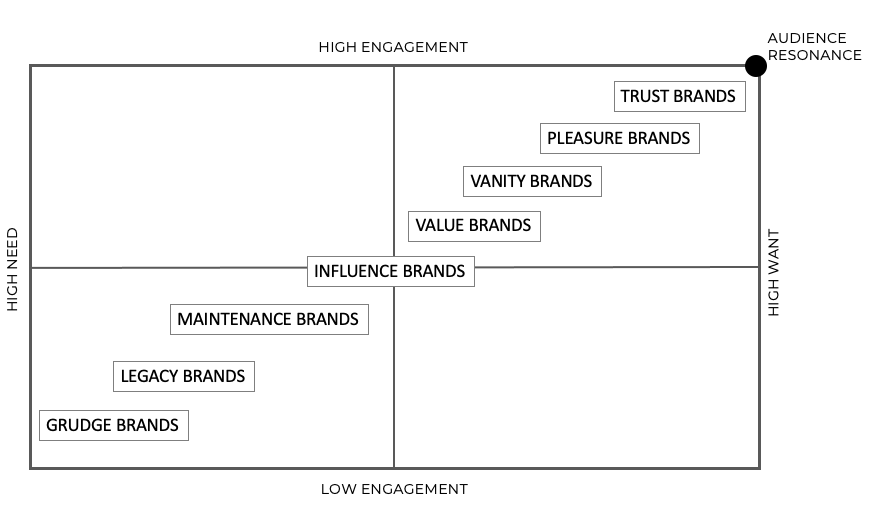Is your company a high-want Vanity Brand? Or is it a high-need Value Brand? And what other companies fall into categories that share those traits? It’s all about customer perceptions.
Companies are generally grouped into classifications determined by common goods and services. Technology, finance, and manufacturing are typical industry classifications. The Global Industry Classification Standard (GICS) developed by Morgan Stanley Capital International (MSCI) and Standard & Poors breaks down industries into Sectors, Industry Groups, Industries, and Sub-industries. These were developed to primarily serve and inform the financial industry. Although there are shared characteristics across industries, does it really matter to customers? There are other ways to look at how your business is classified.
A Brand Perspective
What if businesses were classified into groups according to the brand perceptions of the customers they serve? Businesses classified according to brand perceptions would look quite different. A trust attribute could be shared by a variety of businesses across different industries. They could be quite different in the goods and services they provide. But all of them could be considered a Trust Brand.
Classification According to Customers
Traditional industry segmentation isn’t all that important from a customer perspective. They care about what’s meaningful and relevant to them. Making an emotional connection beyond goods and services is what creates lasting engagement. These can be the attributes that create enduring brand loyalty. Engagement is one consideration that motivates how connected people feel about a brand. High-want versus high-need is a more pragmatic consideration that drives people toward or away from a brand. Taken together they can position a business relative to how well it resonates with their customers. Here are eight examples of how a business could be classified according to engagement, need, want, and resonance.


Trust Brands
Customers are loyal advocates of brands they trust and have confidence in. These are the brands that always deliver on what they promise. They are reliable, dependable, and consistent. Trust Brands are the brands that customers want to engage with. It’s because of a consistent and positive experience. These brands have a reputation built on loyalty. They are high-want as well as high-engagement businesses. But consider that a Trust Brand can be in any industry. Apple and Disney are quite different in what they offer but share a relationship with their customers based on trust.
Pleasure Brands
People are naturally attracted to brands that provide joy and happiness. They are sought after because they bring pleasure, comfort, and contentment. Because they create a strong emotional connection they invite high engagement as a high-want brand. Pleasure brands can be experiential like Disneyworld and Royal Caribbean. But a Pleasure Brand can be as simple as Godiva chocolate.
Vanity Brands
Certain brands feed self-expression and self-admiration to boost one’s ego. They are about being “cool”. They reflect an attitude of self-importance. Wearing a Rolex watch may not tell the time any better than a Timex. However, the perceptions associated with Rolex elevate the perceptions of the individual wearing it. But Vanity Brands are not just luxury brands. They can be at the forefront of a popular trend. The newest iPhone is a statement about being on top of the smartphone trend. Being seen at a Starbucks rather than at a Mcdonald’s makes people feel better. Vanity Brands share a common theme of high-want and high engagement that makes people feel good about themselves.
Value Brands
Many companies provide a benefit at a cost perceived to be lower than its benefit. That’s the value. It’s not about being cheap or discounted. And it’s not about poor quality. In fact, quality is an essential ingredient of a Value Brand. Convenience, service, selection, accessibility, and many other considerations can factor into what makes a Value Brand. Costco and Walmart are traditionally considered Value Brands. In contrast, Nordstrom could also be considered a Value Brand. It’s because their customers value service over price.
Influence Brands
Some brands are more influential than others in shaping public perception about a product, service, purpose, or idea. They tend to strike a balance between need and want. Engagement can be high like with brands like Facebook and Twitter. Or more passive in the case of information sources like the New York Times and CNN. But there are also brands like Patagonia and Tesla which seek to influence attitudes about the environment. Influence Brands can make an important impact on culture and society.
Maintenance Brands
There are many brands that we take for granted and rely on every day. These brands provide the essential staples that maintain our day-to-day needs. These are Maintenance Brands. They lean towards high-need. The degree of engagement is often low. Brands like Safeway and Home Depot fall into this category. But Maintenance Brands don’t have to be national well-known brands. They are often local businesses like plumbing, electrical, and other home service companies.
Legacy Brands
A few companies are left that have been around forever. They are a household name. Their reputation is largely built on longevity. But they are the brands that we can turn to because they have been around for so long. These are Legacy Brands. Because they are so ever-present they don’t necessarily engender high want or high engagement. They are the brands we grew up with and see every day. General Motors, IBM, and General Electric are brands that have spanned generations. Kelloggs, Chlorox, and Hershey are brands that we take for granted that will always be around.
Grudge Brands
How many people look forward to shopping for insurance? Not many. That’s because insurance is a Grudge Brand. It is something that we need but would prefer to avoid if we could. If you have a car you have to get gas (unless it is electric of course). For your smartphone to work you have to have a phone service. Unless you don’t generate any trash you will need a trash pick-up service. These are the brands that are high on need and low on want. They are also the brands that you would prefer to engage with the least. But they serve an important purpose and are a necessity.
It’s Not That Simple
Today’s brands are multi-dimensional. Many have diversified well beyond their core business. Most brands have portfolios of a broad range of products and services. Mergers and acquisitions add to the complexity. That makes it hard to simply categorize any brand into one brand type. A Legacy Brand could also be a Trust Brand. Or a Value Brand could also be a Grudge Brand. Brands are not simple. That’s what makes them interesting. Eight types could easily be 12, 16, or more. Different criteria could translate into entirely different types. There is always more than one way to look at how branding can impact customer perceptions.
Why it Matters
Assigning a brand type category to a company, product or service is not just an academic exercise. It’s just another way to dissect what makes a brand work. Understanding the shared characteristics of other brands can reveal meaningful insights. These might suggest strategies for overcoming low-want or low engagement challenges. Or how to more effectively leverage high-want attributes. Different perspectives can only lead to unrecognized opportunities. That’s how brand works.



